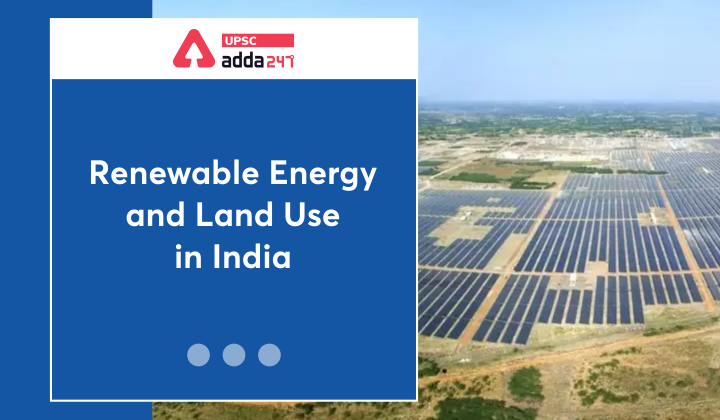Table of Contents
Relevance
- GS 3: Conservation, environmental pollution and degradation, environmental impact assessment.
Context
- Recently, Institute for Energy Economics and Financial Analysis (IEEFA) has released a report named Renewable Energy and Land Use in India by Mid-Century.
About the report
- This report considers the land-use implications of India’s unfolding energy transition and the important choices about where these resources should be located.
- It reviews current land-use studies and then outlines likely future requirements based on the mid-century scenarios.
Key points of the report
- India will use significant stretches of land by 2050 to install renewable energy generation capacities and the land-use increase may have an impact on the environment.
- Around 50,000-75,000 square kilometres of land will be used in 2050 for solar energy generation and for an additional 15,000-20,000 square km for wind energy
- The resulting land cover changes, including indirect effects, will likely cause a net release of carbon up to 50 grams of carbon dioxide per kilowatt-hour.
- Unlike coal-based power, renewable energy generation does not fundamentally change the character of land.
- Electricity generation has to compete with alternative uses for land such as agriculture, urbanisation, human habitation and nature conservation, unlike Europe or the United States of America.
Recommendations
- Minimising total land use requirements for renewable energy:
- Promotion of offshore wind
- Rooftop solar, and solar on water bodies where net environmental benefits can be assured.
- Optimising the identification and assessment of land for renewable generation:
- Developing clear environmental and social criteria for rating potential sites.
- Incentivising the selection of the highest ranked locations in tenders.
- limiting undue regional concentration and supporting widely distributed renewable generation at a range of scales.
- Increasing the stock of potentially suitable land for renewable generation:
- Supporting a major expansion of agrivoltaics research
- Incentivising agrivoltaics uptake where crops, soils and conditions are suitable and yields can be maintained or improved.
Forum for Decarbonizing Transport Project




 TSPSC Group 1 Question Paper 2024, Downl...
TSPSC Group 1 Question Paper 2024, Downl...
 TSPSC Group 1 Answer key 2024 Out, Downl...
TSPSC Group 1 Answer key 2024 Out, Downl...
 UPSC Prelims 2024 Question Paper, Downlo...
UPSC Prelims 2024 Question Paper, Downlo...





